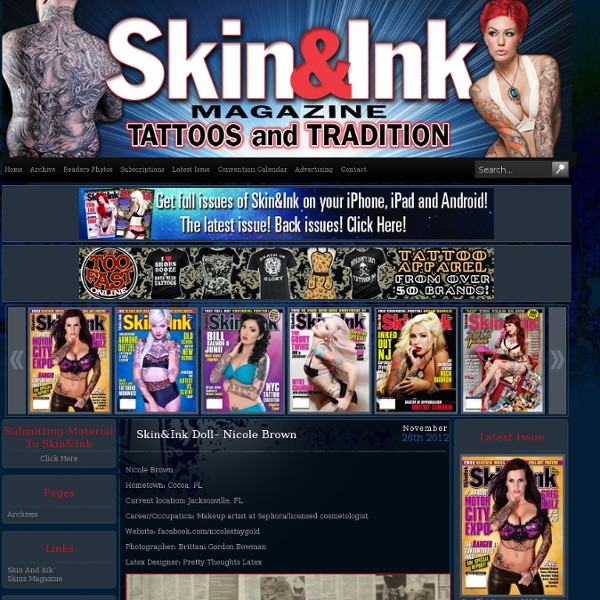



Le Magazine de la Voile Inked Magazine : Tattoo Culture. Style. Art. Magazine motoneiges.ca Create the perfect design portfolio: 30 pro tips | Portfolios How much time do you spend improving your portfolio? Be honest - does it showcase your best stuff? Whether your design portfolio is physical or digital, read on to discover how to create the perfect portfolio today! There's nothing more important to your career than presenting your best work in an attractive, professional and accessible way. We've divided the tips into physical and online portfolios - let's start with the physical... Physical portfolios Physical design portfolios are one-off paper creations, so they can be tailored to the job you are applying for. 01. How many examples should a design portfolio include? 02. Only include design portfolio examples for a full-time position that are appropriate to the role. 03. Illustrators and designers aren't just employed for their style but also for the clarity with which they interpret a creative brief. 04. That doesn't mean, of course, that your design portfolio must only include client work. 05. 06. 07. 08. 09. 10. Online porfolios 11.
Revue GUIDE CROISIÈRE magazine Thriving with FAST MINDS > CHADD - Nationally recognized authority on ADHD by Craig Surman, MD, and Tim Bilkey, MD, with Karen Weintraub OFTEN WHEN CLINICIANS DIAGNOSE ADHD, they look for obvious signs of impairment such as being dismissed from jobs or poor grades at school. But this focus on external consequences misses what it’s like to live with these characteristics every day. It fails to capture the most common burden of what we call FAST MINDS traits: the extra time and effort it takes to compensate—such as late hours at work making up for the constant distractions during the day, or last-minute cramming on projects that won’t get done without deadline pressure. People with FAST MINDS may be living with the constant stress of being reactive rather than proactive—handling demands at the last minute, under stress, rather than being prepared and feeling confident. FAST MINDS explained FAST MINDS is an acronym for the challenges of living with ADHD. When reading the following traits, see if they reflect your experience (or those of someone you care about).
World Soccer Shop - official soccer jerseys, soccer shoes, soccer balls, and gear How to Expand Your Vocabulary: 4 Steps (with Pictures User Reviewed Three Parts:Learning New WordsUsing New WordsBuilding VocabularyCommunity Q&A Learning is ceaseless. You can cultivate an erudite persona as an adolescent--or even as an octogenarian--by building your vocabulary. Ad Steps Part 1 Learning New Words <img alt="Image titled Build Your Vocabulary Step 1" src=" width="728" height="546" class="whcdn" onload="WH.performance.clearMarks('image1_rendered'); WH.performance.mark('image1_rendered');">1Read voraciously. <img alt="Image titled Build Your Vocabulary Step 6" src=" width="728" height="546" class="whcdn">6Read the thesaurus. Part 2 Using New Words Part 3 Building Vocabulary Community Q&A Ask a Question Can you answer these readers' questions? Tips
Maya mythology Maya mythology is part of Mesoamerican mythology and comprises all of the Maya tales in which personified forces of nature, deities, and the heroes interacting with these play the main roles. Other parts of Maya oral tradition (such as animal tales and many moralising stories) do not properly belong to the domain of mythology, but rather to legend and folk tale. Sources[edit] The oldest written myths date from the 16th century and are found in historical sources from the Guatemalan Highlands The most important of these documents is the Popol Vuh or 'Book of the Council'which contains Quichean creation stories and some of the adventures of the Hero Twins, Hunahpu and Xbalanque Yucatán is an equally important region. In the 19th and 20th centuries, anthropologists and local folklorists have committed many stories to paper. Main gods[edit] Important mythical themes[edit] Creation and end of the world[edit] Creation of mankind[edit] Actions of the heroes: Arranging the world[edit] Notes[edit]
The Mayan Pantheon: The many gods of the Maya The pantheon of the Maya is a vast collection of deities who were worshipped throughout the region which, today, comprises Yucatan, Quintana Roo, Campeche, Tabasco, and Chiapas in Mexico and southward through Guatemala, Belize, El Salvador and Honduras. Not all of the gods were venerated in all of the city-states of the Maya (at least, not by the same name) but the type of god, and what that god symbolized to the people, seems to have been universally recognized. An example of this can be seen in the different names given to the underworld by the Yucatec Maya of the north and the Quiche Maya of the south. The Quiche called their underworld `Metnal’ while the Yucatec referred to the same place as `Xibalba’. The gods were involved in every aspect of the life of the Maya. There were over 250 deities in the pantheon of the Maya and, owing to the mass burning of their books by Bishop Diego de Landa in 1562, much information about the gods (and Maya culture) was irretrievably lost.